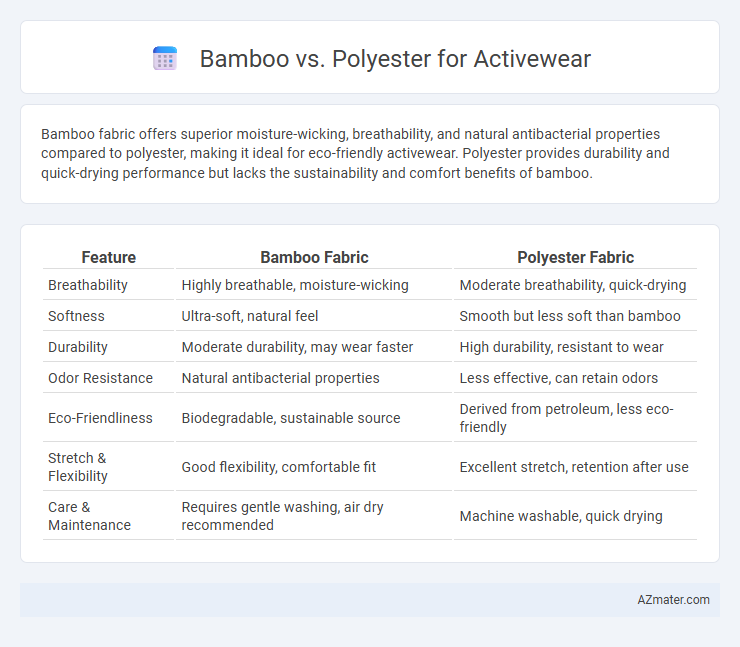Bamboo fabric offers superior moisture-wicking, breathability, and natural antibacterial properties compared to polyester, making it ideal for eco-friendly activewear. Polyester provides durability and quick-drying performance but lacks the sustainability and comfort benefits of bamboo.
Table of Comparison
| Feature | Bamboo Fabric | Polyester Fabric |
|---|---|---|
| Breathability | Highly breathable, moisture-wicking | Moderate breathability, quick-drying |
| Softness | Ultra-soft, natural feel | Smooth but less soft than bamboo |
| Durability | Moderate durability, may wear faster | High durability, resistant to wear |
| Odor Resistance | Natural antibacterial properties | Less effective, can retain odors |
| Eco-Friendliness | Biodegradable, sustainable source | Derived from petroleum, less eco-friendly |
| Stretch & Flexibility | Good flexibility, comfortable fit | Excellent stretch, retention after use |
| Care & Maintenance | Requires gentle washing, air dry recommended | Machine washable, quick drying |
Introduction to Bamboo and Polyester Fabrics
Bamboo fabric, derived from bamboo pulp, is renowned for its natural breathability, moisture-wicking properties, and eco-friendly attributes, making it ideal for activewear. Polyester, a synthetic polymer fabric, offers durability, excellent stretch retention, and quick-drying capabilities, favored in high-performance athletic clothing. Both fabrics serve distinct functions in activewear, balancing comfort, sustainability, and functionality.
Environmental Impact: Bamboo vs Polyester
Bamboo fabric offers a more sustainable alternative to polyester with its rapid growth rate and biodegradability, reducing environmental footprint significantly. Polyester production relies heavily on non-renewable petroleum resources and releases microplastics during washing, contributing to long-term ocean pollution. Choosing bamboo activewear supports lower carbon emissions and reduced water usage, aligning better with eco-friendly apparel goals.
Moisture-Wicking Abilities Compared
Bamboo fabric exhibits superior moisture-wicking abilities compared to polyester due to its highly breathable and absorbent fibers that quickly draw sweat away from the skin, promoting faster evaporation and enhanced comfort during intense physical activity. Polyester, while durable and quick-drying, tends to trap sweat on the surface, which can lead to discomfort and less effective moisture management. Choosing bamboo activewear supports better temperature regulation and reduces odor caused by trapped moisture, making it ideal for high-performance workouts.
Breathability and Comfort in Activewear
Bamboo fabric offers superior breathability due to its natural moisture-wicking properties and soft texture, making it highly comfortable for activewear. Polyester, while less breathable, provides durability and quick-drying features suitable for intense workouts. Choosing bamboo enhances airflow and skin comfort, whereas polyester excels in moisture management and performance longevity.
Durability and Longevity
Bamboo activewear offers moderate durability with natural fibers that resist odors and moisture but tends to wear out faster than polyester under frequent heavy use. Polyester excels in longevity due to its synthetic composition, providing superior resistance to abrasion, stretching, and repeated washing, making it ideal for high-intensity athletic activities. Choosing between bamboo and polyester hinges on balancing sustainability and comfort against durable performance in activewear.
Odor Control Properties
Bamboo fabric naturally exhibits superior odor control properties due to its antibacterial agents called bio-agents, which inhibit the growth of odor-causing bacteria. Polyester, while durable and moisture-wicking, tends to retain odors because synthetic fibers trap bacteria and sweat in the fabric. Activewear made from bamboo is often preferred for prolonged or intense workouts where odor management is crucial.
Skin Sensitivity and Hypoallergenic Factors
Bamboo fabric is highly breathable, naturally antimicrobial, and hypoallergenic, making it ideal for sensitive skin and reducing irritation during activewear use. Polyester, while durable and moisture-wicking, can cause allergies or skin irritation in some individuals due to synthetic fibers and potential chemical treatments. Choosing bamboo activewear supports comfort and skin health, particularly for those prone to eczema or dermatitis.
Care and Maintenance Requirements
Bamboo activewear requires delicate care, including washing in cold water and air drying to preserve its softness and prevent shrinkage, making it eco-friendly yet slightly more demanding than polyester. Polyester activewear offers high durability and quick-drying properties, allowing for easy machine washing and minimal maintenance without losing shape or performance. Choosing between bamboo and polyester depends on balancing eco-conscious care efforts with convenience in activewear maintenance.
Cost and Accessibility
Bamboo activewear often comes at a higher price point due to eco-friendly production processes and limited supply chains, making it less accessible to budget-conscious consumers. Polyester, widely produced and available at a lower cost, dominates the activewear market for affordability and ease of purchase. The cost difference largely stems from the more sustainable nature of bamboo fibers versus the synthetic manufacturing of polyester.
Which is Best for Your Active Lifestyle?
Bamboo activewear offers superior moisture-wicking properties, natural antibacterial benefits, and eco-friendly sustainability, making it ideal for those seeking comfort and environmental responsibility. Polyester excels in durability, quick-drying performance, and vibrant color retention, perfect for intense workouts and extended wear. Choosing between bamboo and polyester depends on whether you prioritize sustainability and softness or resilience and high-performance functionality in your active lifestyle.

Infographic: Bamboo vs Polyester for Activewear
 azmater.com
azmater.com